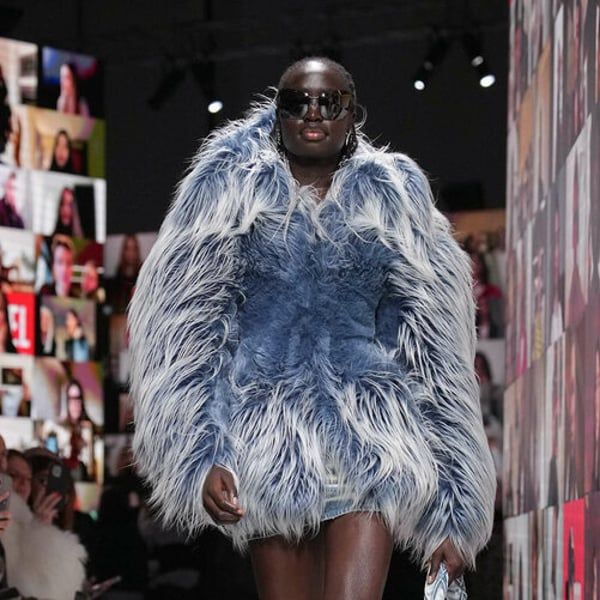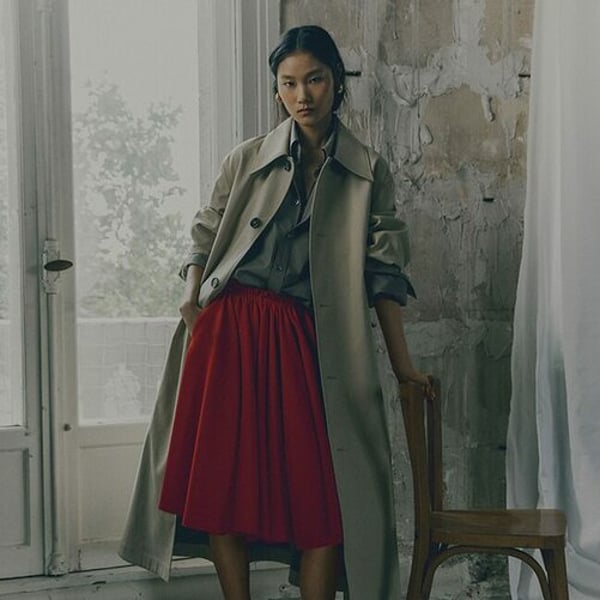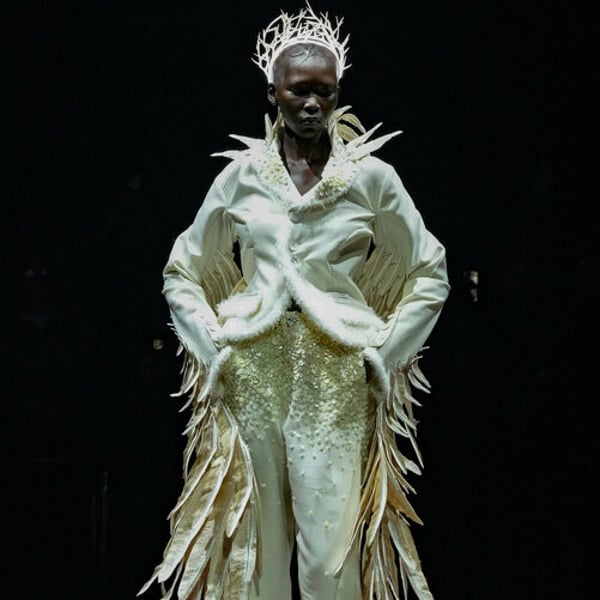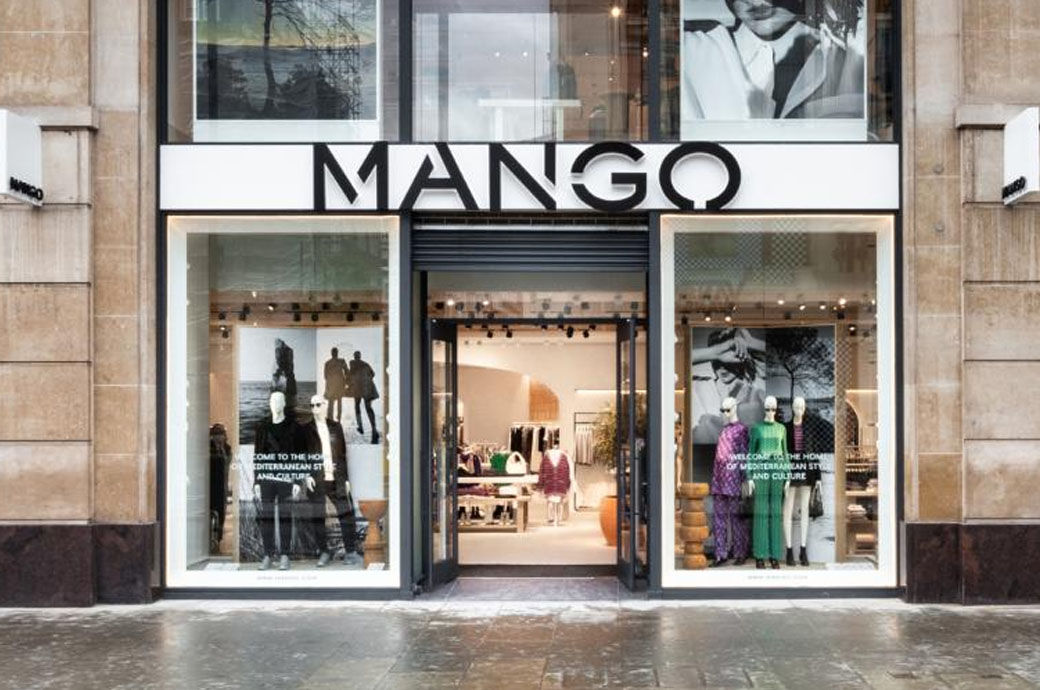Translated by
Cassidy Stephens
Published
February 21, 2024
Milan Fashion Week got off to a tremendously energetic start on Wednesday, presenting some sumptuous collections. It was an opportunity for designers working in the Lombard capital to compete in creativity, expressing themselves in the most diverse styles and universes. For the autumn-winter 2024/25 season, the wardrobe is hyper-textured in Diesel, baroque in Antonio Marras and minimalist classic in Onitsuka Tiger.
Glenn Martens caused a sensation at Diesel with an unprecedented 'phygital' show. Judging by the endless lines of fans gathered at the entrance to the show, which took place in a warehouse on the outskirts of Milan, the designer won his bet, managing to attract a large audience with the jeans brand owned by the OTB group. The creative director continued to democratize the fashion mecca by experimenting with a new format.
A few days before the event, he premiered a live show with several cameras covering the entire process leading up to the parade. For a total of 72 hours, Internet users were able to follow the casting process, the creation of the looks, the changes in the workshops and the assembly of the catwalk until the big day, even joining the public invited to the show through screens. giants.
Guests sat in front of huge screens spread across the vast space, where each digital viewer appeared in a mosaic of small windows. The patchwork was printed as a nod to a miniskirt, bodycon dress and tank top. The physical audience looking at the virtual one, and vice versa, in a game of interchangeable roles between actors and spectators. She started the countdown. 5,4,3, 2, 1, Let's go! The backstage atmosphere burst onto the stage with a loud, booming voice, counting the names of the models as they walked down the catwalk, appearing in front of the guests a few seconds later.

As in previous seasons, the Belgian designer made impressive use of textures. Shirts, T-shirts, tight knit dresses and jeans appeared frayed at the edges or necklines. This effect sometimes revealed entire sections of skin through a layer of sheer tattooed tulle. The floral chiffon dresses and skirts seemed to fall apart, leaving only a few shreds clinging to the lining. Sometimes the torn floral print was fused with a leopard print. This worn effect was replicated on canvas jackets and jeans. The leather outfits were aged. Elsewhere, pants, skirts and coats appeared coated, creating a waxed canvas or shiny inserts.
Wool was also the subject of impressive experiments, with numerous jackets, suits and coats stuffed like old goat hair rugs. Caps bristly with these same raw wool fringes should be a big hit, as they look like furry wigs. Long, soft hairs like feathers were attached to the garments, drawing rhombuses and other abstract lines. On a down jacket, wool flakes were trapped in lozenges under sheer tulle, while long fox-effect hairs with blue highlights were used to create a large, disheveled jacket and a mid-length billowing skirt.
The set was seductive, moving away from denim and entering other universes, from more sophisticated pieces with very feminine suits and dresses to more street-oriented outfits with a tribal spirit.

Antonio Marras transported us to the 14th century, to the court of Leonora de Arborée. A symbol of freedom for the Sardinian people, she reigned in the Judicat d'Arborée, that is, the province of Oristano, preserving its independence from the Crown of Aragon and promulgating one of the first civil codes. It was this heroine that the Sardinian designer chose as his muse this season, mixing medieval princess costumes with a more warrior-like tone.
The coat of arms of this kingdom, with its seven-armed tree, was represented in various prints and jacquards. A camouflage motif was inserted into a wool cape or used to make military suits. Patchwork ensembles were made up of disparate lozenges, like armor, while knitted balaclavas extended to the shoulders like the chainmail balaclavas worn by medieval knights. Red or black checkered tartan was in fashion, especially in kilts. Some coats and dresses were full of black fringes that were both shiny and menacing.
On the other side of the spectrum, Antonio Marras created long, glamorous dresses of red satin, polka dot silk, impalpable chiffon or devoured velvet, combined with majestic capes. Lace was reserved for gloves, stockings and tights. There were also elegant pantsuits, including a gold ribbed one, and embroidery to personalize the different models.

Onitsula Tiger celebrates his 75th birthday. With the Italian stylist Andrea Pompilio at the helm since 2017, she has taken charge of the Rinascente shop windows for the occasion, all covered in the Japanese brand's characteristic yellow. The same pop yellow used in the famous jumpsuit worn by Uma Thurman in Quentin Tarantino's Kill Bill.
In fact, it was the pom-pom girls in pleated skirts and yellow tracksuits who performed over-the-top choreography to open the show. The same yellow enlivened in small flashes, in socks, velvet shoes and sneaker laces, creating a rather austere wardrobe.
For next winter, the brand is focusing on a classic wardrobe of suits, wide-leg pants, hourglass-shaped jackets and cozy coats, all made from felt or thick gray or camel wool sheets. Pinstriped knitwear, cardigans and cozy jumpers complete the wardrobe. The only frivolity: dresses with gold sequins peeking out from a long jacket or coat.
Copyright © 2024 FashionNetwork.com All rights reserved.












